NCERT Solutions Class 10 Science Chapter 3 Metals and Non metals have been provided below and is also available in Pdf for free download. The NCERT solutions for Class 10 Science have been prepared as per the latest syllabus, NCERT books and examination pattern suggested in Class 10 by CBSE, NCERT and KVS. Questions given in NCERT book for Class 10 Science are an important part of exams for Class 10 Science and if answered properly can help you to get higher marks. Refer to more Chapter-wise answers for NCERT Class 10 Science and also download more latest study material for all subjects. Chapter 3 Metals and Non metals is an important topic in Class 10, please refer to answers provided below to help you score better in exams
Chapter 3 Metals and Non metals Class 10 Science NCERT Solutions
Class 10 Science students should refer to the following NCERT questions with answers for Chapter 3 Metals and Non metals in Class 10. These NCERT Solutions with answers for Class 10 Science will come in exams and help you to score good marks
Chapter 3 Metals and Non metals NCERT Solutions Class 10 Science
Question : Explain the meanings of malleable and ductile.
Answer: Malleable: Substances that can be beaten into thin sheets are called malleable. For example, most of the metals are malleable.
Ductile: Substances that can be drawn into thin wires are called ductile. For example, most of the metals are ductile.
Question : Why is sodium kept immersed in kerosene oil?
Answer: Sodium and potassium are very reactive metals and and combine explosively with air as well as water. Hence, they catch fire if kept in open. Therefore, to prevent accidental fires and accidents, sodium is stored immersed in kerosene oil.
Question : Write equations for the reactions of
(i) iron with steam
(ii) calcium and potassium with water
Answer:
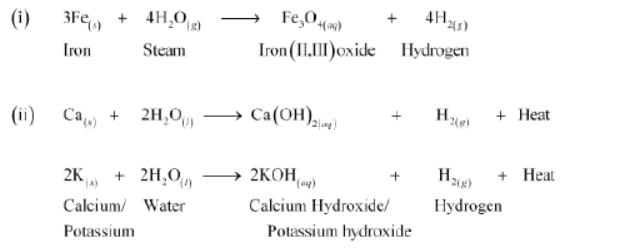
Question : Samples of four metals A, B, C and D were taken and added to the following solution one by one. The results obtained have been tabulated as follows. MetalIron (II) sulphateCooper (II) sulphateZinc sulphate Silver nitrate
A. No reaction Displacement
B. Displacement No reaction
C. No reaction No reaction No reaction Displacement
D. No reaction No reaction No reaction No reaction Use the Table above to answer the following questions about metals A, B, C and D.
(i) Which is the most reactive metal?
(ii) What would you observe if B is added to a solution of copper (II) sulphate?
(iii) Arrange the metals A, B, C and D in the order of decreasing reactivity.
Answer: Explanation
A + FeSO4 →¨ No reaction, i.e., A is less reactive than iron
A + CuSO4 →¨Displacement, i.e., A is more reactive than copper
B + FeSO4 →¨ Displacement, i.e., B is more reactive than iron
B + ZnSO4 →¨No reaction, i.e., B is less reactive than zinc
C + FeSO4 →¨ No reaction, i.e., C is less reactive than iron
C + CuSO4 →¨No reaction, i.e., C is less reactive than copper
C + ZnSO4 →¨No reaction, i.e., C is less reactive than zinc
C + AgNO3 →¨ Displacement, i.e., C is more reactive than silver
D + FeSO4/CuSO4/ZnSO4/AgNO3 →¨No reaction, i.e., D is less reactive than iron, copper, zinc, and silver
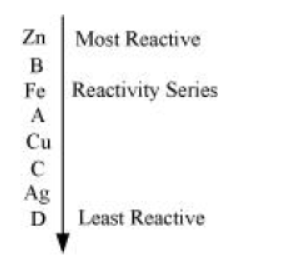
(i) B is the most reactive metal.
(ii) If B is added to a solution of copper (II) sulphate, then it would displace copper.
B + CuSO4 →Displacement
(iii) The arrangement of the metals in the order of decreasing reactivity is:
B > A > C > D
Question : Which gas is produced when dilute hydrochloric acid is added to a reactive metal? Write the chemical reaction when iron reacts with dilute H2SO4.
Answer: Hydrogen gas is evolved when dilute hydrochloric acid is added to a reactive metal. When iron reacts with dilute H2SO4, iron (II) sulphate with the evolution of hydrogen gas is formed.

Question : What would you observe when zinc is added to a solution of iron (II) sulphate?Write the chemical reaction that takes place.
Answer: Zinc is more reactive than iron. Therefore, if zinc is added to a solution of iron (II) sulphate, then it would displace iron from the solution.

Question : (i) Write the electron-dot structures for sodium, oxygen and magnesium.
(ii) Show the formation of Na2O and MgO by the transfer of electrons.
(iii) What are the ions present in these compounds?
Answer: (i) The representation of elements with valence electrons as dots around the elements is referred to as electron-dot structure for elements.
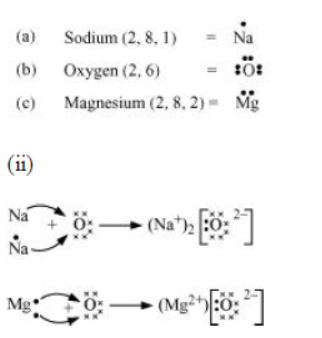
Question : Why do ionic compounds have high melting points?
Answer: Ionic compounds have strong electrostatic forces of attraction between the ions. Therefore, it requires a lot of energy to overcome these forces. That is why ionic compounds have high melting points.
Question : Define the following terms.
(i) Mineral (ii) Ore (iii) Gangue
Answer: (i) Mineral: Most of the elements occur in nature as in combined state as minerals. The chemical composition of minerals is fixed.
(ii) Ore: Minerals from which metals can be extracted profitably are known as ores.
(iii) Gangue: The impurities (sand, silt, soil, gravel, etc.) present in the ore are called gangue.
Question : Name two metals which are found in nature in the free state.
The metals at the bottom of the reactivity series are mostly found in free state. For example: gold, silver, and platinum.
Question : What chemical process is used for obtaining a metal from its oxide?
Answer: The chemical process used for obtaining a metal from its oxide is reduction. In this process, metal oxides are reduced by using suitable reducing agents such as carbon or by highly reactive metals to displace the metals from their oxides.
For example, zinc oxide is reduced to metallic zinc by heating with carbon.

Question : Metallic oxides of zinc, magnesium and copper were heated with the following metals.
Metal Zinc Magnesium Copper
Zinc oxide - - -
Magnesium oxide - - -
Copper oxide - - -
In which cases will you find displacement reactions taking place?
Answer:
Metal Zinc Magnesium Copper
Zinc oxide No reaction Displacement No reaction
Magnesium oxide No reaction No reaction No reaction
Copper oxide Displacement Displacement No reaction
Question : Which metals do not corrode easily?
Answer: More reactive a metal is, more likely it is to be corroded. Therefore, less reactive metals are less likely to get corroded. This is why gold plating provides high resistance to corrosion.
Question : What are alloys?
Answer: Alloys are homogeneous mixtures of two or more elements. The elements could be two metals, or a metal and a non-metal. An alloy is formed by first melting the metal and then dissolving the other elements in it. For example, steel is an alloy of iron and carbon.
Question : Which of the following pairs will give displacement reactions?
(a) NaCl solution and copper metal
(b) MgCl2 solution and aluminium metal
(c) FeSO4 solution and silver metal
(d) AgNO3 solution and copper metal.
(d) AgNO3 solution and copper metal
Question : Which of the following methods is suitable for preventing an iron frying pan from rusting?
(a) Applying grease
(b) Applying paint
(c) Applying a coating of zinc
(d) all of the above.
Answer: (c) Applying a coating of zinc
(We can also apply grease and paint to prevent iron from rusting. However, in case of iron frying pan, grease and paint cannot be applied because when the pan will be heated and washed again and again, the coating of grease and paint would get destroyed.)
Question : An element reacts with oxygen to give a compound with a high melting point. This compound is also soluble in water. The element is likely to be
(a) calcium
(b) carbon
(c) silicon
(d) iron
Answer: (a) The element is likely to be calcium
Question : Food cans are coated with tin and not with zinc because
(a) zinc is costlier than tin.
(b) zinc has a higher melting point than tin.
(c) zinc is more reactive than tin.
(d) zinc is less reactive than tin.
Answer: (c) Food cans are coated with tin and not with zinc because zinc is more reactive than tin.
Question : You are given a hammer, a battery, a bulb, wires and a switch.
(a) How could you use them to distinguish between samples of metals and non-metals?
(b) Assess the usefulness of these tests in distinguishing between metals and non-metals.
Answer: (a) With the hammer, we can beat the sample and if it can be beaten into thin sheets (that is, it is malleable), then it is a metal otherwise a non-metal. Similarly, we can use the battery, bulb,wires, and a switch to set up a circuit with the sample. If the sample conducts electricity, then it is a metal otherwise a non-metal.
(b) The above tests are useful in distinguishing between metals and non-metals as these are based
on the physical properties. No chemical reactions are involved in these tests.
Question : What are amphoteric oxides? Give two examples of amphoteric oxides.
Those oxides that behave as both acidic and basic oxides are called amphoteric oxides.
Examples: aluminium oxide (Al2O3), zinc oxide (ZnO)
Question : Name two metals which will displace hydrogen from dilute acids, and two metals which will not.
Answer: Metals that are more reactive than hydrogen displace it from dilute acids.
aFor example: sodium and potassium. Metals that are less reactive than hydrogen do not displace it. For example: copper and silver.
Question : In the electrolytic refining of a metal M, what would you take as the anode, the cathode and the electrolyte?
Answer: In the electrolytic refining of a metal M:
Anode →Impure metal M
Cathode → Thin strip of pure metal M
Electrolyte → Solution of salt of the metal M
Question : Pratyush took sulphur powder on a spatula and heated it. He collected the gas evolved by inverting a test tube over it, as shown in figure below.
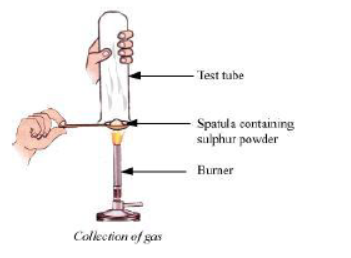
(a) What will be the action of gas on
(i) dry litmus paper?
(ii) moist litmus paper?
(b) Write a balanced chemical equation for the reaction taking place.
Answer: (a) (i) There will be no action on dry litmus paper.
(ii) Since the gas is sulphur dioxide (SO2), it turns moist blue litmus paper to red because sulphur dioxide reacts with moisture to form sulphurous acid.
(b)

Question : State two ways to prevent the rusting of iron.
Answer: Two ways to prevent the rusting of iron are:
(i) Oiling, greasing, or painting: By applying oil, grease, or paint, the surface becomes water proof and the moisture and oxygen present in the air cannot come into direct contact with iron. Hence,rusting is prevented.
(ii) Galvanisation: An iron article is coated with a layer of zinc metal, which prevents the iron to come in contact with oxygen and moisture. Hence, rusting is prevented.
Question : What type of oxides is formed when non-metals combine with oxygen?
Answer: Non-metals combine with oxygen to form acidic oxides.
For example:

Question : Give reasons
(a) Platinum, gold and silver are used to make jewellery.
(b) Sodium, potassium and lithium are stored under oil.
(c) Aluminium is a highly reactive metal, yet it is used to make utensils for cooking.
(d) Carbonate and sulphide ores are usually converted into oxides during the process of extraction.
Answer: (a) Platinum, gold, and silver are used to make jewellery because they are very lustrous.
Also, they are very less reactive and do not corrode easily.
(b) Sodium, potassium, and lithium are very reactive metals and react very vigorously with air as well as water. Therefore, they are kept immersed in kerosene oil in order to prevent their contact with air and moisture.
(c) Though aluminium is a highly reactive metal, it is resistant to corrosion. This is because aluminium reacts with oxygen present in air to form a thin layer of aluminium oxide. This oxide layer is very stable and prevents further reaction of aluminium with oxygen. Also, it is light in weight and a good conductor of heat. Hence, it is used to make cooking utensils.
(d) Carbonate and sulphide ores are usually converted into oxides during the process of extraction because metals can be easily extracted from their oxides rather than from their carbonates and sulphides
Question : You must have seen tarnished copper vessels being cleaned with lemon or tamarind juice. Explain why these sour substances are effective in cleaning the vessels.
Answer: Copper reacts with moist carbon dioxide in air to form copper carbonate and as a result,copper vessel loses its shiny brown surface forming a green layer of copper carbonate. The citric acid present in the lemon or tamarind neutralises the basis copper carbonate and dissolves the layer. That is why, tarnished copper vessels are cleaned with lemon or tamarind juice to give the surface of the copper vessel its characteristic lustre.
Question : Differentiate between metal and non-metal on the basis of their chemical properties.
Answer:
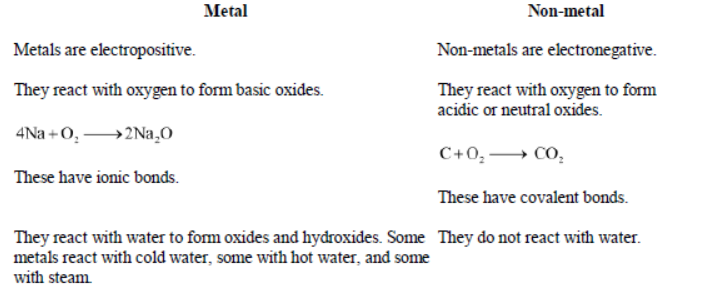
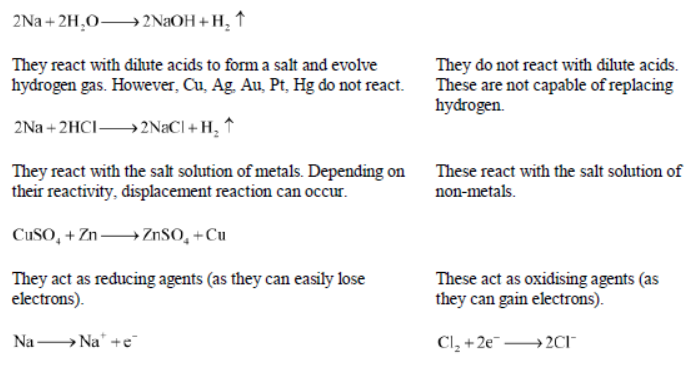
Question : A man went door to door posing as a goldsmith. He promised to bring back the glitter of old and dull gold ornaments. An unsuspecting lady gave a set of gold bangles to him which he dipped in a particular solution. The bangles sparkled like new but their weight was reduced drastically. The lady was upset but after a futile argument the man beat a hasty retreat.Can you play the detective to find out the nature of the solution he had used?
Answer: He must have dipped the gold metal in the solution of aqua regia − a 3:1 mixture of conc. HCl and conc. HNO3. Aqua regia is a fuming, highly corrosive liquid. It dissolves gold in it.
After dipping the gold ornaments in aqua regia, the outer layer of gold gets dissolved and the inner shiny layer appears. That is why the weight of gold ornament reduced.
Question : Give reasons why copper is used to make hot water tanks and not steel (an alloy of iron).
Answer: Copper does not react with cold water, hot water, or steam. However, iron reacts with steam. If the hot water tanks are made of steel (an alloy of iron), then iron would react vigorously with the steam formed from hot water.

That is why copper is used to make hot water tanks, and not steel.
| NCERT Solutions Class 10 Science Chapter 1 Chemical Reactions and Equations |
| NCERT Solutions Class 10 Science Chapter 2 Acids Bases and Salts |
| NCERT Solutions Class 10 Science Chapter 3 Metals and Non metals |
| NCERT Solutions Class 10 Science Chapter 4 Carbon and its Compounds |
| NCERT Solutions Class 10 Science Chapter 5 Periodic Classification of Elements |
| NCERT Solutions Class 10 Science Chapter 6 Life Processes |
| NCERT Solutions Class 10 Science Chapter 7 Control and Coordination |
| NCERT Solutions Class 10 Science Chapter 8 How do Organisms Reproduce |
| NCERT Solutions Class 10 Science Chapter 9 Heredity and Evolution |
| NCERT Solutions Class 10 Science Chapter 10 Light Reflection and Refraction |
| NCERT Solutions Class 10 Science Chapter 11 Human Eye and Colourful World |
| NCERT Solutions Class 10 Science Chapter 12 Electricity |
| NCERT Solutions Class 10 Science Chapter 13 Magnetic Effects of Electric current |
| NCERT Solutions Class 10 Science Chapter 14 Sources of Energy |
| NCERT Solutions Class 10 Science Chapter 15 Our Environment |
| NCERT Solutions Class 10 Science Chapter 16 Management of Natural Resources |
NCERT Solutions Class 10 Science Chapter 3 Metals and Non metals
The above provided NCERT Solutions Class 10 Science Chapter 3 Metals and Non metals is available on our website for free download in Pdf. You can read the solutions to all questions given in your Class 10 Science textbook online or you can easily download them in pdf. The answers to each question in Chapter 3 Metals and Non metals of Science Class 10 has been designed based on the latest syllabus released for the current year. We have also provided detailed explanations for all difficult topics in Chapter 3 Metals and Non metals Class 10 chapter of Science so that it can be easier for students to understand all answers. These solutions of Chapter 3 Metals and Non metals NCERT Questions given in your textbook for Class 10 Science have been designed to help students understand the difficult topics of Science in an easy manner. These will also help to build a strong foundation in the Science. There is a combination of theoretical and practical questions relating to all chapters in Science to check the overall learning of the students of Class 10.
You can download the NCERT Solutions for Class 10 Science Chapter 3 Metals and Non metals for latest session from StudiesToday.com
Yes, the NCERT Solutions issued for Class 10 Science Chapter 3 Metals and Non metals have been made available here for latest academic session
Regular revision of NCERT Solutions given on studiestoday for Class 10 subject Science Chapter 3 Metals and Non metals can help you to score better marks in exams
Yes, studiestoday.com provides all latest NCERT Chapter 3 Metals and Non metals Class 10 Science solutions based on the latest books for the current academic session
Yes, NCERT solutions for Class 10 Chapter 3 Metals and Non metals Science are available in multiple languages, including English, Hindi
All questions given in the end of the chapter Chapter 3 Metals and Non metals have been answered by our teachers

